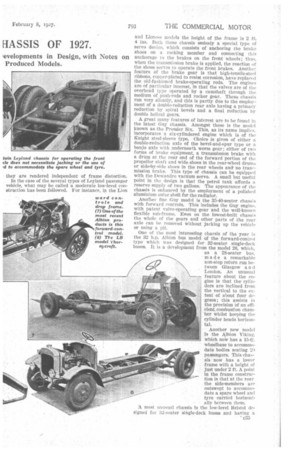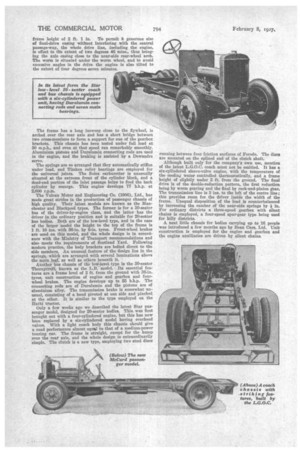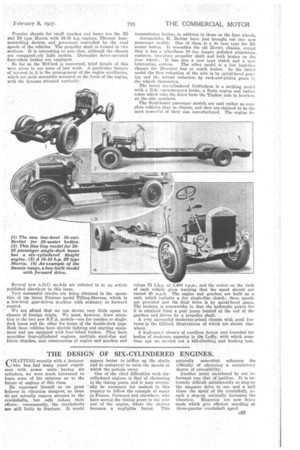PASSENGER VEHIC
Page 98

Page 99

Page 100

Page 101

If you've noticed an error in this article please click here to report it so we can fix it.
HASS'S OF 1927.
-vvE INCLUDED in our issue of last year devoted to passenger travel an article concerning tendencies in the design of chassis for passenger vehicles. and it is interesting to note how, in chassis which have been produced recently, many of the points to which we drew attention have been embodied. The Commercial Vehicle Exhibition of 1925 was, in the main, devoted to the passenger vehicle, and there, for the first time, were to be seen many new examples of vehicles designed with a low-frame level. At the time, and for a considerable while after, there was much criticism of this development, but from the fact that practically every new passenger vehicle which has been produced since that period embodies this principle of construction it is obvious that it has given satisfaction, for, after all, it is useless for the maker to produce chassis which do not please the popular fancy.
The majority of passenger vehicles is now equipped with pneumatic tyres, and this, through the advent of the six-wheeler, has even been extended to double-deck buses seating up to 68 passengers, but in this article we do not intend to deal with the six-wheeler, as we treat with this type elsewhere in the issue.
As a result of the production of chassis capable, with single-deck bodies, of attaining speeds up to 4a m.p.h., it has become essential to embody front-wheel brakes in the design. Such brakes have been approved on certain buses for work in London. The use of these additional brakes, combined with the need for greater power in their application, has resulted in a demand for servo devices which will relieve the driver of the necessity for exerting excessive effort, and these have also shown themselves to be of great benefit.
It has been proved that, by careful design, the provision of a low frame-level need not involve lack of accessibility to important parts of the chassis which may require attention This is a point which should overcome the objections of the few who still consider that the low-level chassis prevents mechanical disadvantages. • In many recent models far more attention has been paid to details which are likely to promote the general efficiency of the vehicle and increase its life. We may mention thermostats which reduce the period of cold working after starting, air filters which prevent the ingress of dust and grit to the working parts of the engine, improved types of filter for the oil, whilst only recently, following the production of a satisfactory type of vibration damper for heavy vehicles, many coaches and buses are being so equipped, with great benefit both to the vehicles and their passengers. Here, again, we wiluld refer our readers to an article on the subject appearing elsewhere in this issue.
It is obvious that in the space of an article of this type we cannot include full details of all new passenger chassis on the market; we will, therefore, confine ourselves to pointing out special features AMbodied in some of the most important.
We may well commence with the Dennis low-level bus chassis, which gives a frame height of 2 ft. when loaded and embodies a very effective servo c32
trake mechanism constructed under Rolls-Royce patents and consisting of a plate-clutch device driven by skew gearing from a gearbox shltft. It is a type which, in conjunction with the front-wheel brakes, has been approved for service in the Metropolis. A small but interesting feature on Dennis products is that the brake shafts are carried in spherical bearings, so that
they are rendered independent of frame distortion. In the ease of the several types of Leyland passenger vehicle, what may be called a moderate low-level construction has been followed. For instance, in the Lion and Lioness models the height of the frame is 2 ft. 4 Ins. Both these chassis embody a special type of servo device, which consists of anchoring the brake shoes on a rocking member and connecting this anchorage to the brakes on the front wheels; thus, when the transmission brake is applied, the reaction of the shoes serves to operate the front brakes. Another feature of the brake gear is that high-tensile-steel ribbons, copper-plated to resist corrosion, have repla•eed the old-fashioned brake-operating rods. The engines are of particular interest, in that the valves are of the overhead type operated by a camshaft through the medium of push-rods and rocker gear. These chassis run very silently, and this is partly due to the employment of a double-reduction rear axle having a primary reduction by spiral bevels and a final reduction by double helical gears.
A great many features of interest are to be. found in the latest Guy chassis. Amongst these is the model known as the Premier Six. This, as its name linplics, incorporates a six-cylindered engine which is of the Knight steel-sleeve type. Ohoice is given of either a double-reduction axle of the bevel-and-spur type or a banjo axle with _underneath worm gear: either of two forms of brake equipment, a transmission brake with a drum at the rear end of the forward portion of the propeller shaft and wide shoes in the rear-wheel drums or side-by-side shoes in the rear wheels andno traitsmission brake. This type of chassis can be equipped with the llewandre vacuum servo. A small but useful point in the design Is that the petrol tank affords a reserve supply of two gallons. The appearance of the chassis is enhanced by the employment of a polished
aluminium outer shell for the radiator. • Another fine Guy model is the 35-40-seater chasisis
with forward controls. This includes the Guy engine. with patent valve-operating gear and the well-known flexible sub-frame. Even on the lowest-built chas-sis the whole of the gears and other parts of the rear axle can be removed without jacking up the vehicle or using a pit.
One of the most interesting chassis of the year is the 32 h.p. Albion bus model of the forward-control type which was designed for 32-seater single-deck buses. It is a development from the model 26, which, as a 28-seater bus, made a remarkable non-stop return run between Glasgow a n London. An unusual feature about the engine is that the cylinders are inclined from the vertical to the extent of about four degrees; this assists in the provision of an efficient combustion chamber whilst keeping the cylinder heads horizon tal. •
Another new model is the Albion Viking, which now has a 15-1t. wheelbase to accommodate bodies seating 2(} passengers, This chassis now has a lower frame with a height of just under 2 ft. A point in the frame construction is that at the rear the side-members are outswept to accommodate a spare wheel and tyre carried horizontally between them. A most unusual chassis is the low-level Bristol designed for 82-seater single-deck buses and having a "c33
frame height of 2 ft. 1 in. To permit it generous size of final-drive casing without interfering with the central pal:wage-way, the whole drive line, including the engine, is offset to the extent of two degrees 46 mins., thus bringing the axle casing close to the near-side rear-wheel arch. The worm is situated under the worm wheel, and to avoid excessive angles in the drive the engine is also tilted to the extent of four degrees seven minutes.
The frame has a long insweep close to the flywheel, is arched over the rear axle and has a short bridge between two cross-members to form a support for one of the gearbox brackets. This chassis has been tested under full load at 50 m.p.h., and even at that speed ran remarkably smoothly. Aluminium pistons and Duralumin connecting rods are used in the engine, and the braking is assisted by a Dewandre servo.
The springs are so arranged that they automatically stiffen under load, and Timken roller bearings are employed for the universal joints. The Salem carburetter is unusually situated at the extreme front of the cylinder block, and a dead-end portion of the inlet passage helps to feed the back cylinder by resurge. This engine develops 77 b.h.p. at 2,000 r.p.m.
The Vulcan Motor and Engineering Co. (1908), Ltd., has made great strides in the production of passenger chassis of high quality. Their latest models are known as the Manchester and Blackpool types. The former is for a 30-seater bus of the driver-by-engine class, and the latter has the driver in the ordinary position and is suitable for 20-seater bus bodies. Both are of the low-level type, and in the case of the larger model the height to the top of the frame is 1 ft. 10 ins. with 36-in. by 6-in. tyres. Front-wheel brakes are used on this model, and the whole design is in accordance with the Ministry of Transport recommendations and also meets the requirements of Scotland Yard. Following modern practice, the body brackets are bolted direct to the aide members. An unusual feature of the design lies in the springs, which are arranged with several laminations above the main leaf, as well as others beneath it.
Another bus chassis of the low-level type is the 30-seater Thornycroft, known as the L.B. model. Its essential features are a frame level of 2 ft. from the ground with 36-in. tyres, unit construction of engine and gearbox and fourwheel brakes. The engine develops up to 55 b.h.p. The connecting rods are of Dnralumin and the pistons are of aluminium alloy. The transmission brake is somewhat unusual, consisting of a bend pivoted at one side and pinched at the other. It is similar to the type employed on the Eathi tractor.
Only a few weeks ago we described the latest Star passenger model, designed for 20-seater bodies. This was first brought out with a four-cylindered engine, but this has now been replaced by a six-cylindered model having overhead valves. With a light coach body this chassis should give a road performance almost equal to that of a medium-power touring car. The frame is straight, except for the hump over the rear axle, and the whole design is extraordinarily simple. The clutch is a new type, employing two steel discs running between four friction surfaces of Ferodo. The discs are mounted on the splined end of the clutch shaft.
Although built only for the company's own use, mention of the latest L.G.O.C. coach must not be omitted. It has a six-eylindered sleeve-valve engine, with the temperature of the cooling water controlled thermostatically, and a frame height of slightly under 2 ft. from the ground. The final drive is of the double-reduction pattern, the first reduction being by worm gearing and the final by rack-and-pinion gear. The transmission line is 3 ills, to the left of the centre line; this provides room for the driver inside the width of the frame. Unequal disposition of the load is counterbalanced by increasing the camber of the near-side springs by in. For ordinary districts a three-speed gearbox with silent chains is employed, a four-speed spur-gear type being used for hilly districts.
A neat little chassis for bodies carrying up to 16 people was introduced a few months ago by Bean Cars, Ltd. Unit construction is employed for the engine and gearbox and the engine auxiliaries are driven by silent chains.
Popular chassis for small coaches and buses are the Z5 and Z6 type Morris with 16-35 h.p. engines, Titertnit heatcontrolling devices and governors controlled by the road speeds of the vehicles. The propeller shaft is formed in two sections. It is interesting to note that, although the chassis are comparatinly light models. Dewandre servo-operated four-wheel brakes are employed.
• So far as the ArcCurd is concerned, brief details • of this were given in oar issue of last week. A•particular feature of interest in it is the arrangement of the engine auxiliaries, which are most accessibly mounted at the front of the engine, with the dynamo situated vertically.
Several new A.D.C. mcdels are referred to in an article published elsewhere in this issue.
Very successful results are being obtained in the operation of the latest Express model Tilling-Stevens, which is a low-level gear-driven re4ochine with ordinary or forward " control.
We are afraid that we can devote very little space to chassis of foreign origin. We must, however, draw attention to the two new S.P.A. models—one for coaches or singledeck buses and the other for buses of the double-deck type. Both these vehicles have electric lighting and starting equipment and are equipped with four-wheel brakes. They have mouoldoc four-cylindered engines, multiple steel-disc and fabric clutches, unit construction of engine and gearbox and transmission brakes, in addition to those on the four wheels, Automobiles U. Bernet have just brought out two new e models. One Of them is a de luxe type for 20seater bodies. It resembles the old 35-cwt, chassis, except that it has a wheelbase 10 ins, longer, polished alumieium. radiator, two-piece propeller shaft and both brakes on the rear wheel >. It has also a new type clutch and a new lubricating system, The other model is a low load-line chassis for 20-seater bus or coach bodies. In the lathe. model the first reduction of the axle is by spiral-bevel gearing and ths second reduction by rack-and-pinion gears in the wheels themselves.
The latest six-cyliudered Gotfredson is a striking model with a B.K. vacuum-servo brake, a Buda engine and radius tubes which take the drive from the Timken axle to brackets on the side members.
The Studebaker passenger Models are sold rather as complete vehicles than as chassis, and they are claimed to be the most powerful of their size manufactured. The engine de velops 75 b.h.p. at 2,400 r.p.m., and the notice on the dash of each vehicle gives warning that the speed should not exceed 45 m.p.h. The engine and gearbox are built as a unit, which includes a dry single-disc clutch; three speeds are provided and the ,final drive is by spiral-bevel gears. The braking is noteworthy in that the hydraulic power for it is obtained from a gear pump located at the end of the gearbox and driven by a propeller shaft.
A very successful moderate-priced chassis with good features is the Gifford, illustrations of which are shown elsewhere.
A high-speel cltassie of excellent design and intended for bodies of moderate capacity is the Left with which some time ago we eaeried out a kill-climbing and braking test.




































































































































































































